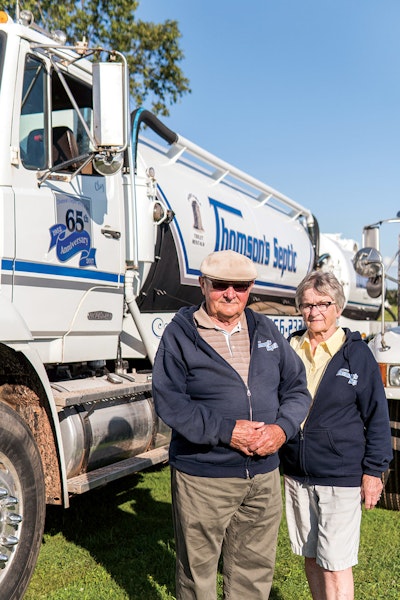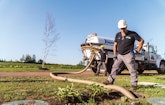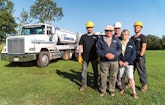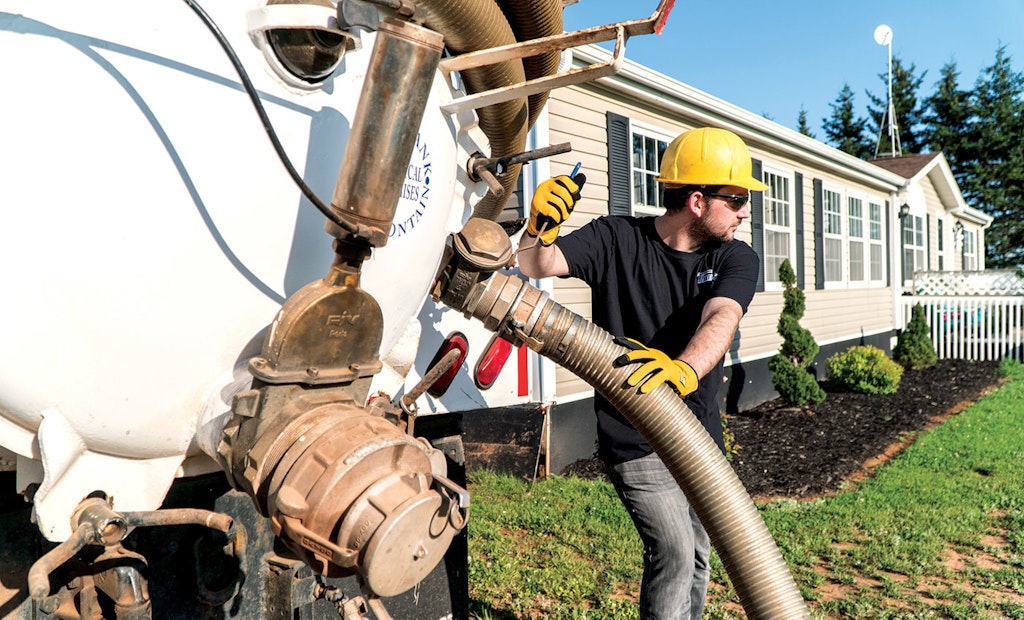Thomson’s Septic Tank Service was founded in the province of Prince Edward Island in 1952 by David Thomson and his wife, Loretta, offering three main services — construction of septic tanks, septic tank service and cleaning sewer laterals. Today, the business continues to thrive on its devotion to traditional service, willingness to embrace new products and technology, and a healthy dose of island grit and self-reliance.
The company is now owned by David Thomson Jr., who is 77, and his wife, Gloria, the company’s office administrator. David is still heavily involved, handling all the estimates, permits and the lion’s share of troubleshooting.
“My father was a plumber and pipe fitter by trade, and he worked for a local foundry,” David says. “He left that position to start the septic business when I was 10. It was hard work. They — he and a couple of men he’d hired — dug the septic tank and field beds by hand and built the tanks of cement blocks.”
It was already a family business. David Sr.’s grandfather Fulton worked for the company, and young David was soon also attracted to the business, fascinated by the equipment his father operated. Their first service truck was a 1947 Chevrolet 1-ton with a 360-gallon tow-behind tank outfitted with a Monarch pump driven by a Wisconsin engine. His father died in 1962, and David Jr., at age 20, stepped up to operate the business alongside his mother. He bought the business outright in 1970.
His son, Clay Thomson, the company foreman, was born in 1965 and his first recollections regarding the business begin when he was 4 years old. “I was born in the business,” he says. “It was also the equipment that drew me — trucks, backhoes and whatever. I remember riding along on the old diaphragm pumper trucks. I jumped in here full time after high school and never left.”
TOOLS IMPROVE
As time marched forward, Thomson’s took advantage of new technology. Vacuum pumps replaced diaphragm pumps in the 1970s. In 1988, the company switched to polyethylene septic tanks and currently purchase them from Infiltrator Water Technologies. In 1991, Thomson’s began using leachfield chambers from Infiltrator.
“I liked the idea of leaching chambers instead of pipe and gravel,” David says. “It cut down on transporting gravel and took up less space. Many of the older lots here are 100 by 100 feet, and you have to keep the septic system 50 feet from the well.”
The company added portable restrooms in 1999. It was a last-minute decision to meet a request from the provincial Department of Fisheries to supply long-term rental units, which Thomson’s would service.
Today, Thomson’s offers services in a 25-mile radius of Warren Grove, near the capital city of Charlottetown. But 25 miles covers a lot of the territory of the small island province.
The family business employs five people full time, including Clay’s stepson John MacRae and Mike Appleton, who isn’t related. Three part-time employees also help out, including Clay’s son Alan, who keeps busy on welding chores.
DO IT YOURSELF
Thomson’s operates two vacuum trucks, both built out in-house. The first is a 1995 International with a 5,050-gallon steel tank and Fruitland pump. The second is a 1989 Freightliner, with a 4,325-gallon steel tank and Fruitland pump.
“We buy the ends of the tanks at Vacutrux in Elmira, Ontario, and we go on from there, getting the barrel rolled and installing the frame rails and baffles,” Clay says. “It provides work for our staff during the slower winter months. We have a 30-by-50-foot shop with all the amenities — welders and torches and a steel lathe. We’ll also handle other chores, from engine tuneups to regrooving our truck tires.”
Thomson’s recently moved an older 3,850-gallon steel tank from the Freightliner and secured it to a pup trailer the company assembled about a dozen years ago. The Freightliner will haul the trailer to increase liquid waste capacity.
“Not only that, but you can haul two different types of liquid loads at the same time since the units are independent,” Clay says.
Thomson’s also employs a John Bean sewer jetter used in combination with a vacuum truck to rejuvenate traditional tile beds or clean leaching chambers of sludge.
A pair of Caterpillar machines provide construction support: a 2002 420 backhoe loader and a 2011 303C mini hydraulic excavator.
GETTING WORK DONE
Thomson’s offers 28 single portable restrooms supplied by PolyJohn Canada. They’re used primarily for long-term rentals to construction or agriculture clients, but the company also takes on weekend weddings and other small events.
“The portable restrooms can help fill out a week if business is slow,” Clay says. “But at the end of the day, the numbers are also good.”
Pumping keeps the company busy, whether it’s service to customers with septic tanks, pumping its own portable restrooms or serving island industries and communities.
“We’ve done municipal pumping, potato processing plants, fish processing plants, ships, dairies and feed mills,” Clay says. “We’ve even pumped a few trains and one jet plane. Most of this work isn’t contracted. It’s requested on an as-needed basis.”
About half the residential septic pumping customers are regularly scheduled, while the other half shops around on price. Thomson’s, however, won’t engage in price wars.
“My opinion is that as pumpers as well as installers, we have the experience and ability to identify existing or potential problems that might not be apparent to someone who is primarily a septic pumper,” Clay says. “That’s worth something.”
The company encourages customers to treat their septic waste with enzymes to keep septic systems clear. They’re currently using enzymes supplied by Lenzyme Trap-Cleer.
FOLLOW THE RULES
The pumping business in Prince Edward Island is heavily regulated.
Several years ago, the province ended the practice of land-applying septage. Now, only two locations accept liquid waste: the municipal systems of the cities of Charlottetown and Summerside. That’s increased disposal costs, but it has also resulted in a better environmental profile for the industry.
However, the two locations are only open from 8 a.m. to 4 p.m. To cope, Thomson’s has installed two 10,800-gallon, double-wall, fiberglass storage tanks — formerly underground gasoline storage tanks — on its premises.
In order to meet all regulatory requirements, Thomson’s sometimes visits a site 15 to 18 times before a septic system installation is complete.
“We’re also asked to inspect our own work,” David says. “But government reinspections are rare. We support the regulations, but we’d like to see more vigorous inspections of the final work to ensure all contractors play by the same rules.”
The company has, however, resisted a provincial initiative encouraging all installers to become certified to offer perc tests directly to property owners.
“It offers the potential for installers to categorize the condition of the soil in such a way as to create more work for themselves,” Clay says. “We continue to dig the holes for the test pit, but use a third-party engineer to conduct the perc test. That way the customer can have confidence in the results.”
KEEP PLUGGING AWAY
Thomson’s advertised on radio years ago but finds that traditional advertising has diminished in effectiveness — no flyers, mailers or other advertising. More and more customers are finding the Thomson’s website using search engines. A new website may be under development soon, and Clay says they will become more proactive in figuring out exactly how customers are finding them.
A charitable effort also builds goodwill.
“If we do a certain amount of work in some smaller communities and they need the septic tank in their community hall pumped, for instance, we’ll often do that for free,” Clay says. “We might be named on their signboard for a week or so, and it builds recognition.”
One day, Clay is likely to take the helm of the business, but his father shows no signs of slowing down.
“We’ll all stay involved as long as we can,” Clay says. “I enjoy the business. You’ll never get rich working here, but I love the tremendous variety of the work. You’re always learning something new, and no two days are the same.”
A passion for vintage equipment
David Thomson Jr., co-owner of Thomson’s Septic Tank Service, recalls he first became interested in his father’s business when the company purchased a small Farmall Cub tractor to backfill the tank and tile bed installations with gravel.
“I loved that little tractor and never forgot it,” he says.
In fact, Thomson remained so intrigued with those early memories that he restored two vintage Farmall Cub tractors — a 1948 and 1950 model.
“The 1950 model was built out of two Cubs, which we joined together as a fun project,” David says. “We widened it out to two seats and installed air horns and a hydraulic canopy that goes up and down for special events and parades.”
A 1948 Ford 8N rounds out the tractor collection. The family has also restored a 1967 Harley-Davidson three-wheel side-by-side golf cart, but Thomson recently traded it for a 2010 Polaris all-terrain vehicle with four-wheel drive and a small dump box.
“I’m eager to take it out to the shore this year and load it up with bar clams,” he says.










